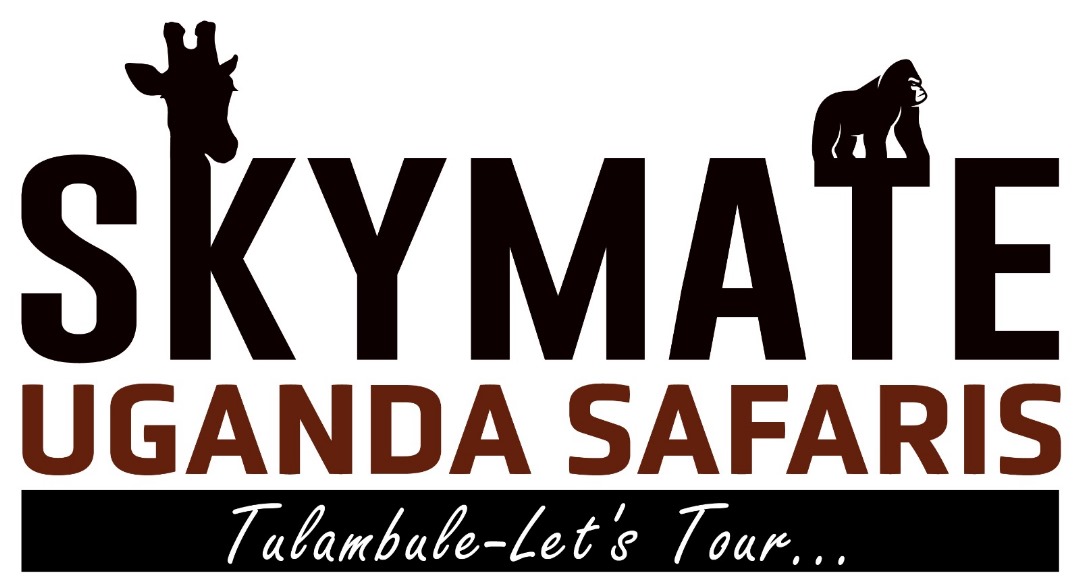Table of Contents
ToggleVolcanoes National Park in Rwanda is the most accessible gorilla trekking destination in Africa. Established in 1925, it is also Africa’s oldest national park and home to some of the most luxurious safari accommodation on the continent.
This beautiful Rwanda national park is also where the legendary American Primatologist Dian Fossey studied and protected Gorillas for 18 years until her death in 1985. It is a place where against so many odds, the critically endangered mountain gorillas have flourished.
Here, special daily gorilla trekking excursions offers visitors the once-in-a-lifetime opportunity to come face-to-face with these magnificent gentle giants, which can weigh over 200 kg and share almost 98% of their DNA with us humans. And while the mountain gorillas may be the stars, visitors always find themselves blown away by park’s breathtaking scenery and astonishing biodiversity.
Vegetation types include misty bamboo forest, Afro-montane rainforests, Afro-alpine shrubland, thicket, and grassland with marshes and small lakes interspersed.
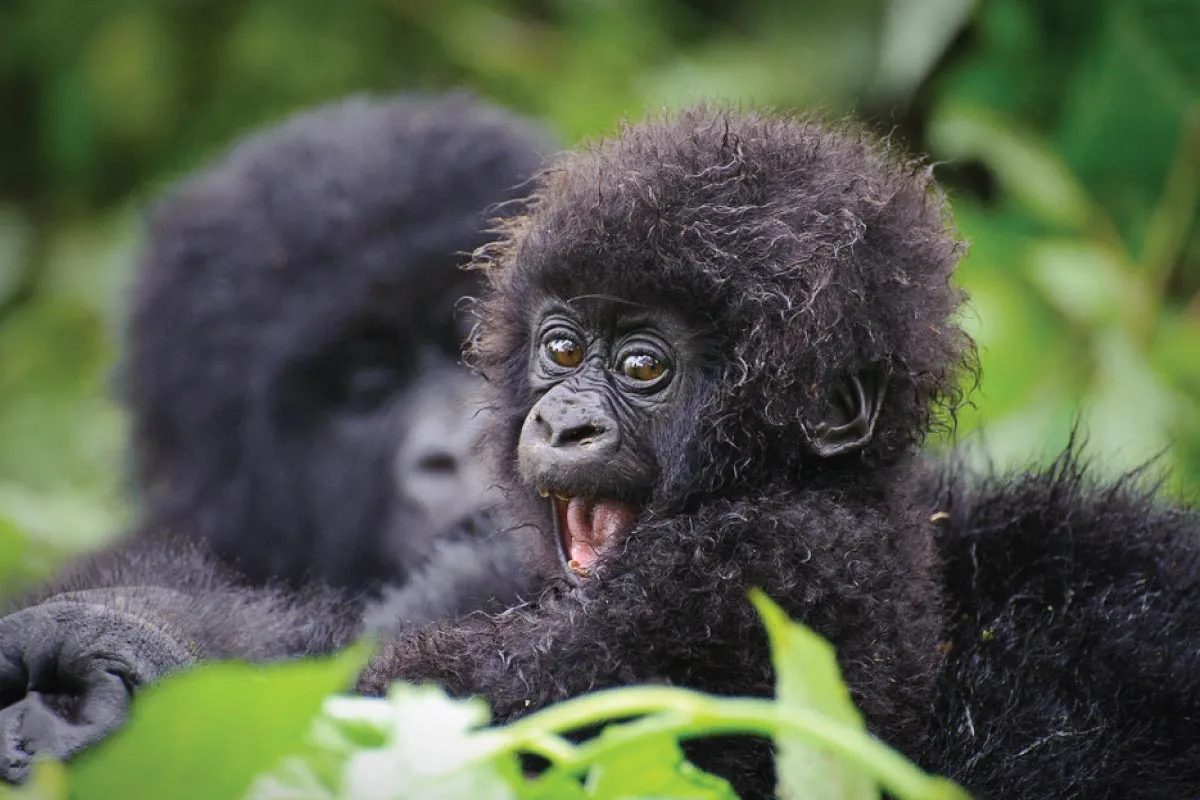
Why Is Volcanoes National Park Rwanda Important?
Volcanoes National Park In Rwanda is a success story for country’s conservation and communities. The rich biodiversity of the national park is home to the highly endangered mountain gorilla and the endemic golden monkey. The park also generates employment opportunities, livelihood and infrastructure development, community projects and so much more.
Why is it called Volcanoes National Park?
Volcanoes National Park in Rwanda is named after the dormant volcanoes located within it. The park protects a vital portion the Virunga Mountains, a spectacular series of eight volcanoes that rises from the Great Rift Valley escarpment to a high point of 4,507 meters. Most of the Volcanoes National Park lies at over 2,000 metres above sea level – not high enough to cause altitude sickness but something that certainly takes some getting used to for unacclimatised visitors.
How Many Volcanic Mountains Are In Rwanda’s Volcanoes National Park?
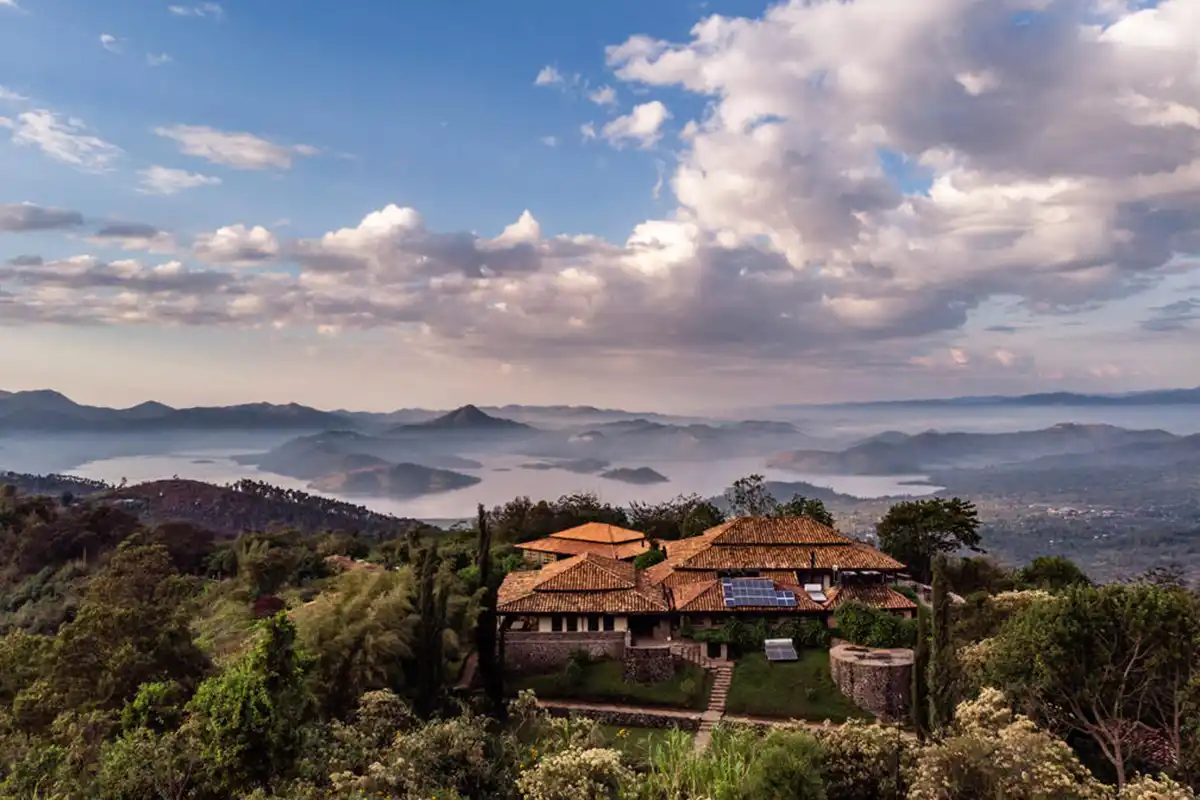
Volcanoes National Park is home to 5 of the 8 volcanic Virunga Mountains. These mountains are the products of ferocious geological forces that shaped this section of the Great Rift Valley.
All 5 of the Virunga Volcanoes on the Rwandan side have long since retired from spewing lava (although there are 2 active volcanoes in the range in the neighbouring Democratic Republic of Congo), but their presence in the park is no less dramatic for their dormancy. The highest volcano in the park is Mount Karisimbi at 4507 meters/14787 feet. Other volcanoes in the park include:
- Mount Muhabura (4127 meters/13540feet)
- Mount Bisoke (3711 meters/12175 feet)
- Mount Sabyinyo 3,669 meters (12,037 feet)
- Mount Gahinga (3474 meters /11398 feet)
How Big Is Volcanoes National Park In Rwanda?
Volcanoes National Park is approximately 160 square kilometers in size. Rwanda is the 4th smallest country on the African continent, covering an area of about 26 340 square kilometers (10 170 square miles).
Where Is Volcanoes National Park Located In Rwanda?
Volcanoes National Park is located in the north-western corner of Rwanda. The park is situated near the town of Musanze, formerly known as Ruhengeri. Volcanoes National Park’s offices are based in the small village called Kinigi, in the Musanze area. This park is found in the Virunga chain of volcanoes on the borders of Uganda and the Democratic Republic of Congo.
With DR Congo’s Virunga National Park in the west and Mgahinga Gorilla National Park in Uganda to the north, Volcanoes National Park is part of the Greater Virunga Conservation Area. This trio of countries acts as the guardians of just over half of the world’s remaining population of endangered mountain gorillas, living on the forest-swathed slopes of the imposing volcanoes.
How Far Is Volcanoes National Park From Kigali In Rwanda?
Volcanoes National Park is Africa’s easiest gorilla trekking destination to access. It is only about 80 kilometer (50 miles) from Kigali, the capital city of Rwanda. This means it takes about 2 to 3 hours to drive from Kigali International Airport (KGL) to Volcanoes National Park on a good paved road.
It is possible to embark on day trips to Volcanoes for gorilla trekking. But, we advise against day tours as it is just too far and there is so much more to see in and around Volcanoes National Park.
What is unique about Volcanoes National Park Rwanda?
1. Its Africa's Oldest National Park
Volcanoes National Park is the oldest national park in Africa. It established in 1925. It was formerly called Albert National Park, after Belgium’s King Albert I.
A few years later (in 1929) the park was expanded into the Congo and it was run by the Belgian colonial authorities who were in charge of both colonies.
In the 1960s it was split into two national parks, namely Virunga National Park in the Congo and Volcanoes National Park in Rwanda. In the 1990s the Rwandan genocide devastated the country and the park became a battlefield and tourism ceased.
After years of turmoil, the Rwanda Government re-launched tourism and conservation efforts in Volcanoes National park. In 2005 they introduced the Kiwita Izina (a baby gorilla naming ceremony) for tourists, involving the local community
2. It's Home To Over 300 Mountain Gorillas
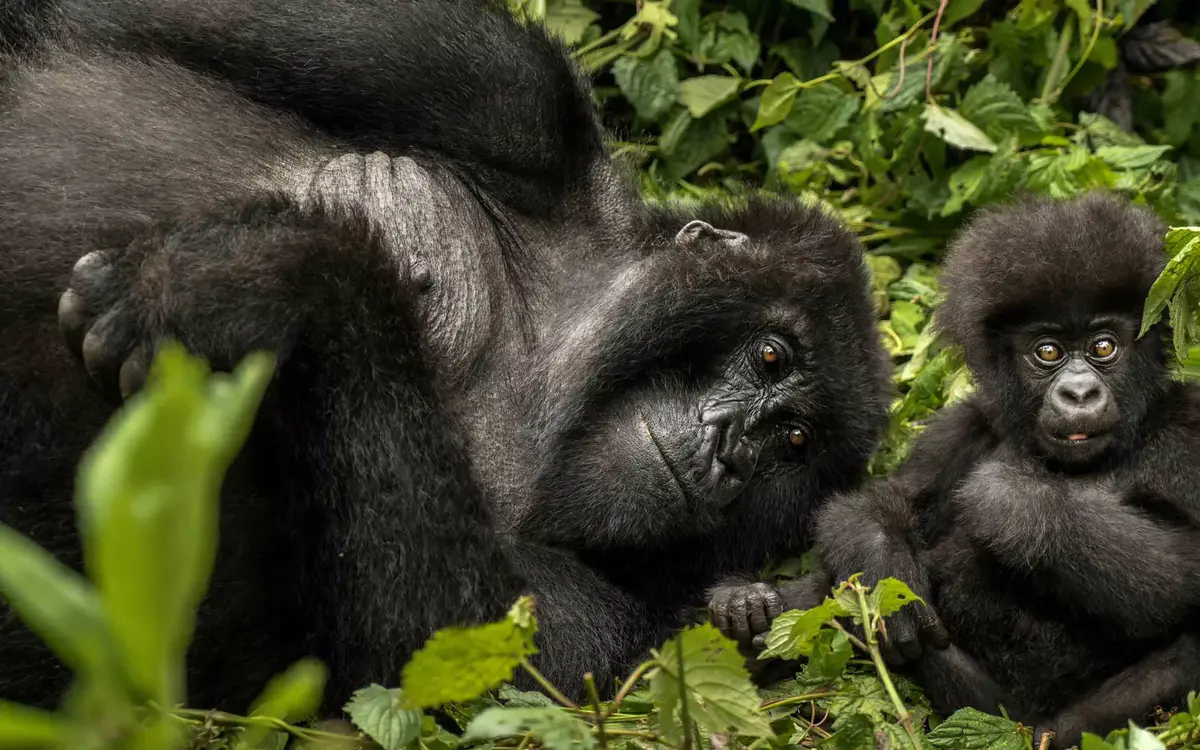
Volcanoes National Park is famous for its gorilla trekking safaris. The park protects about 300 mountain gorillas – around half the world’s existing population – and is the scene for what is often described as Africa’s easiest gorilla trekking. It is one of the three places to go mountain gorilla trekking in Africa. That means it is one of only three places in the entire world where you can come face-to-face with mountain gorillas in the wild. No small claim to fame!
3. Its Where Dian Fossey Conducted Her Gorilla Research
Volcanoes National Park is also where famous American primatologist Dian Fossey spent 18 years of her life studying and saving the amazing Mountain Gorillas from extinction. The survival of these magnificent human cousins is largely credited to her work.
Fossey made incredible discoveries about Gorillas. Initially, Gorillas had a terrible reputation as savage beasts that would kill a human on sight. In her study and love of these apes, she demolishes this myth. Living alongside Gorilla families, Fossey showed to the world that these massive ground-dwelling apes are actually gentle giants. In many ways, they are like us.
Slowly, she gained their trust and could sit near them and observe their daily lives. Accurately, she documented what they ate and how they vocalized and studied their social relationships. This method of gaining Gorilla’s trust is called Gorilla Habituation, Fossey’s great gift to the world.
Sadly, with all her work and struggles in fighting poachers over the years, Fossey had also made many enemies, especially among those who benefitted from this illegal trade. This haunted her on a dark night in 1985 when she was brutally hacked to death with a crude machete. She was laid to rest in the gorilla graveyard in Volcanoes National Park next to her favorite Gorilla friend, Digit.
4. It's Where "Gorillas in the Mist " Movie Was Filmed
Later, Dian Fossey’s story was beautifully portrayed in the popular Hollywood movie ‘Gorillas in the Mist’ (1988), which was also the title of the book she wrote. The movie was filmed here in Volcanoes National Park in Rwanda.
5. Troops of Endemic Golden Monkeys
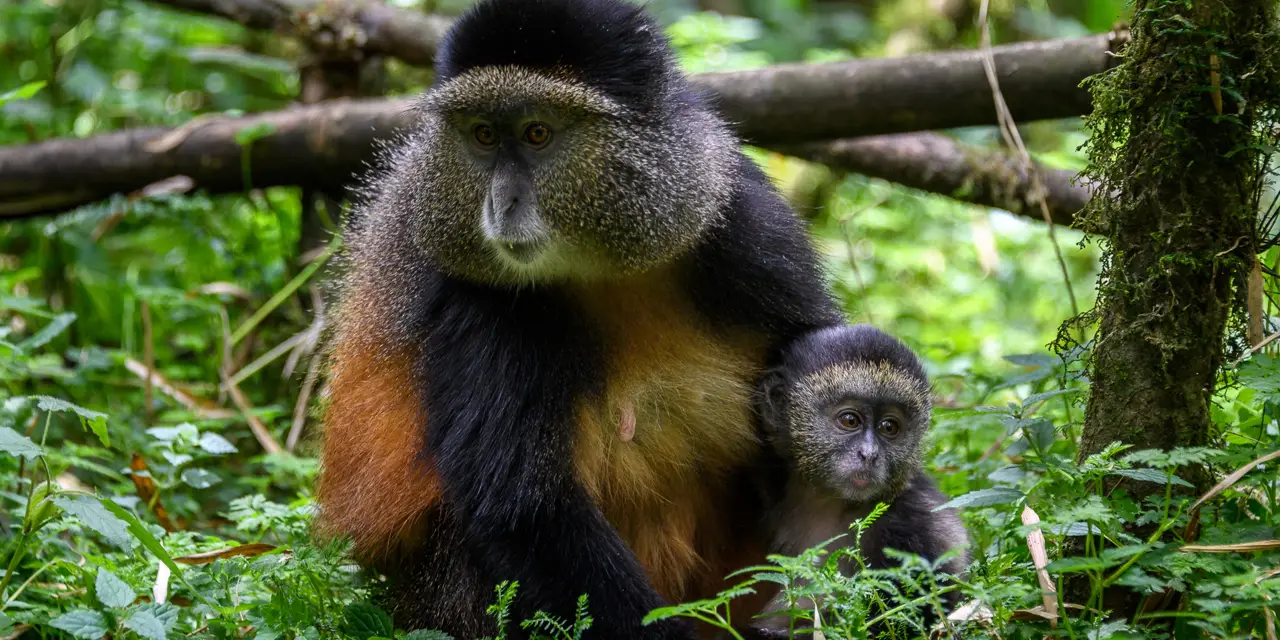
In addition to its endangered mountain gorillas, Volcanoes National Park is also home to troops of habituated golden monkeys. These charismatic monkeys are almost as scarce as their gorilla cousins and are only found around the Virunga region. They are among the most beautiful of African monkeys
With their attractive facial mane, auburn capes of fur, and perpetually surprised expressions, the golden monkeys are the perfect photographic subjects, and their antics are endlessly entertaining. Tracking them is less expensive and not as difficult as gorilla trekking, so many visitors add this activity to their visit.
6. Home to Over 200 Species of Unique Birds
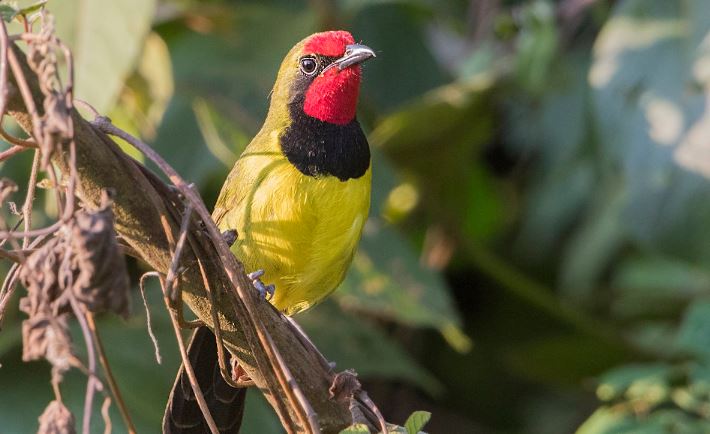
Like Nyungwe Forest National Park in southern Rwanda, Volcanoes National Park offers some of the best birding in East Africa. This bird-watching haven has over 200 different recorded species, including 17 Albertine Rift endemics. Some of the avian specials here include:
- Bronze sunbird
- Scarlet-tufted sunbirds
- Rwenzori Turacos
- Handsome Francolins
- Rwenzori double-collared sunbirds
- African green broadbills
- Rwenzori batises
- Archer’s robin-chat
- Doherty’s bush-shrike
- Dusky crimsonwing
- Grauer’s swamp warbler
- Lagden’s bush-shrike
- Red-faced woodland warbler
- Ruwenzori apalis
- Ruwenzori nightjar
- Strange weaver
7. beautiful scenery with Five volcanoes
Besides wildlife attractions, visitors are always blown away by the breathtaking scenery of Volcanoes National Park. The park protects the Rwandan sector of the Virunga Volcanoes. The beautiful scenery consists of a chain of these freestanding mountains, connected by forested saddles. The mountain gorillas are often found along these saddles, in enormous groves of bamboo.
How many gorilla families are in Volcanoes National Park?
There are 12 gorilla families in Volcanoes National Park that have been habituated for tourism (other families are habituated solely for research purposes). Each gorilla family consists of several females and their young and is lead a by a silverback male. On a guided trek you can spend up to an hour in their presence – plenty of time to observe their family dynamics, snap pictures, and make lifetime memories. The gorilla families in Volcanoes National Park in Rwanda include:
- Susa Gorilla Family
- Igisha Gorilla Family
- Karisimbi Gorilla Family
- Sabyinyo Gorilla Family
- Amahoro Gorilla Family
- Agashya Gorilla Family
- Kwitonda Gorilla Family
- Umubano Gorilla Family
- Hirwa Gorilla Family
- Bwenge Gorilla Family
- Ugyenda Gorilla Family
- Muhoza Gorilla Family
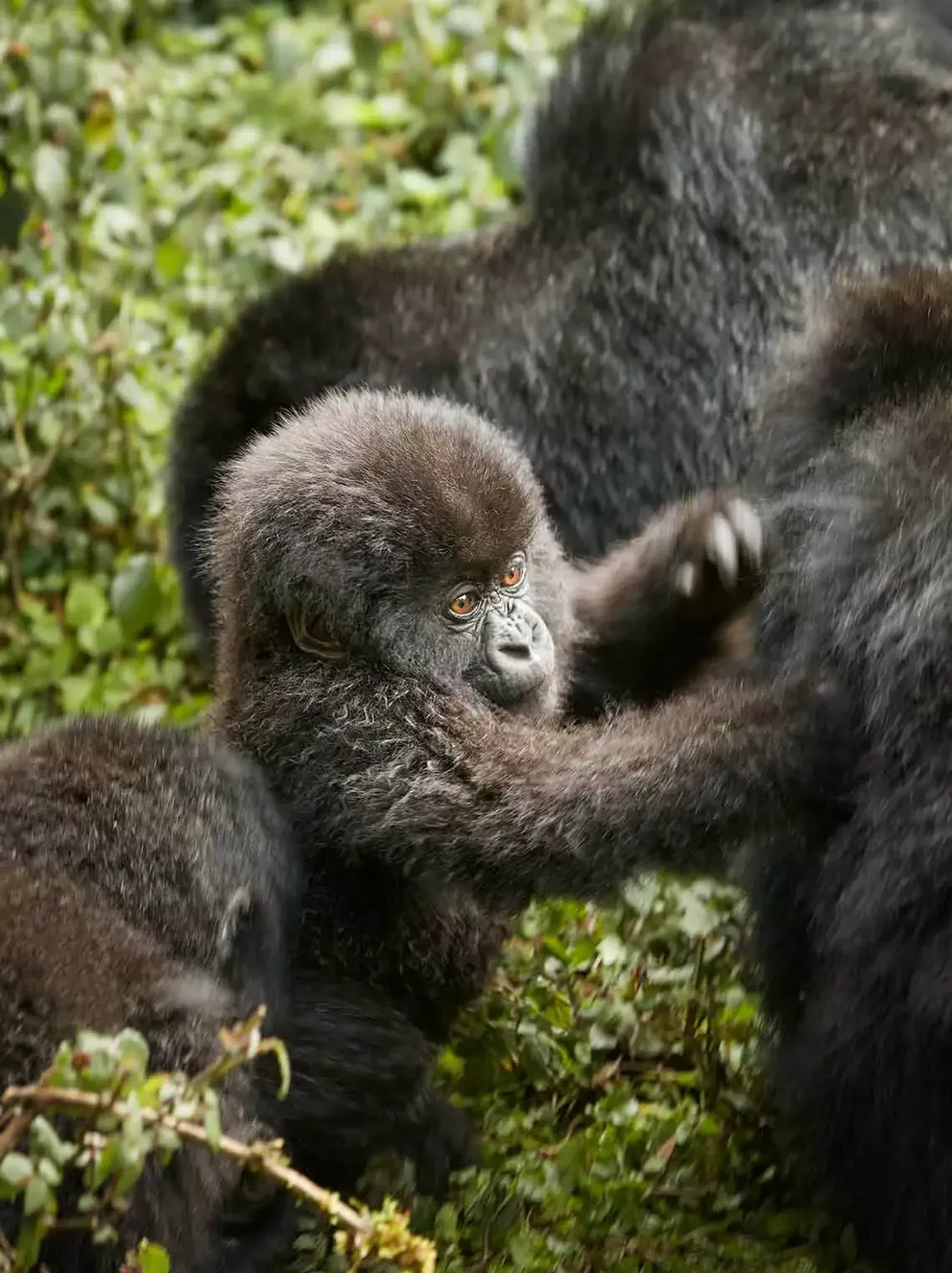
Rwanda Gorilla Trekking In Volcanoes National Park
Described by many as a life-changing experience, gorilla trekking is certainly one of Africa’s most sought-after bucket-list experiences. But perhaps more importantly, your gorilla trek directly empowers a huge ongoing conservation success story.
All Rwanda gorillas trekking takes place in Volcanoes National Park. The adventure takes you through the verdant afro-montane forests. Of course, your main focus will be mountain gorillas (read more about these gentle giants here), but you will encounter other wonderful species, such as golden monkeys, colourful Rwenzori Turacos and prehistoric three-horned chameleons – amongst others. You’ll be guided by experienced local ranger guides.
how does gorilla trekking in Volcanoes National Park In Rwanda compare to other parks?
Volcanoes National Park in Rwanda is generally regarded to be the easiest place to track mountain gorillas and a good choice for anyone who is unsure about their fitness. This is because the park’s habituated gorilla family groups are predictably territorial and can usually be found quite close to the forest edge, which is reached along any of several relatively flat footpaths.
Trekking conditions at Volcanoes National Park’s main competitor, Uganda’s Bwindi Impenetrable National Park, are less inherently predictable and often involve long walks through steep and densely forested slopes. The main negative of Volcanoes National Park is that the gorilla trekking permit costs US$1,500 per person as compared to US$700 in Uganda.
How much time do you have with the gorillas?
You will spend a maximum of one hour in the company of the mountain gorillas on any given gorilla-watching outing. This does not include time spent trekking to find the gorillas or the descent back to the trailhead. Generally, if the gorillas are located in difficult terrain or the middle of a downpour, the guides will suggest you wait a while before joining the gorillas and starting the clock.
what Fitness Level Is Required For Gorilla Trekking In Volcanoes National Park In Rwanda?
You don’t need to be super fit to go gorilla trekking in Volcanoes National Park and moderately fit people should not find it too challenging. In most cases, the hike from the trailhead to the forest edge is quite flat and easy, though the altitude might leave you out of breath.
Once in the forest, the terrain can be more challenging. But you generally won’t need to walk too far or too fast. And the porters are used to assisting struggling trekkers up the steep and slippery slopes.
Visitors who are older than 50 and/or out of shape may find the trek more challenging. However, they can take heart from the fact that all people of 15 years and above and fitness levels have tracked gorillas in Volcanoes National Park in Rwanda.
And while gorilla sightings are not guaranteed, the success rate is around 99%. It helps that the guides usually have a good idea of how tough the hike to any given gorilla family will be on any given day, so they are able to allocate the easier options to elderly or less-fit trekkers.
What preparations are advised for gorilla trekking in Volcanoes National Park in Rwanda?
Gorilla trekking in Volcanoes National Park takes place at high altitudes (up to 3,000 meters/9,842 feet). Thus, it is worth spending a few days acclimatizing in the nearby highlands, especially if you are unused to hiking and/or live close to sea level.
No special training is required for a gorilla trek. But if you would be daunted by the prospect of a two-hour walk at home, then try to build yourself up to a level where you can cover that distance in your stride. To protect you against stinging nettles, long sleeves are recommended. And long trousers tucked into long socks and solid walking shoes will help to deter biting ants.
Remember to carry a rainjacket, hat, sunblock and up to two liters of drinking water. A good walking stick is very useful in the forest interior, but you don’t need to bring one from home, as you will be offered one before you set off on the gorilla trekking adventure. Porters are also available to carry your day pack and to help push and pull you up any tricky slippery slopes.
How Much Will A Volcanoes National Park Gorilla Trekking Tour Cost?
The cheapest 2-day Rwanda gorilla trekking safaris to Volcanoes NP of the capital Kigali start at around US$ 2,000 per person. These are usually inclusive of transport from Kigali, a transfer to the trailhead, accommodation, meals and the US$1,500 gorilla trekking permit. Rwanda gorilla tours to Volcanoes National Park that use more luxurious accommodation or that are longer than 2 days will have a significantly higher price.
Which other activities are available in Volcanoes National Park In Rwanda?
A wide variety of guided hikes and treks are available in Volcanoes National Park. These include:
- Golden monkey trekking in the bamboo zone
- Hiking to Dian Fossey’s grave located in a scenic spot between Bisoke and Karisimbi volcano
- A scenic day hike to the Crater Lake at the 3,711m/12,175ft summit of Mount Bisoke
- An overnight route to the top of Mount Karisimbi, the highest point in the park
- Hike to the Mount Muhavura to look out across the Twin Lakes of Burera and Ruhondo (separated by an ancient Lava flow)
- A subterranean stroll through the atmospheric Musanze Caves
- Cultural visit to the nearby Iby’iwacu Cultural Village (Gorilla Guardian Village)
- Visiting the Great Lakes of Ruhondo and Bulera
Which other parks should I visit on a trip that includes a gorilla trek in Volcanoes?
Rwanda is home to two other well-established national parks. And visiting all three offers you a unique chance to see gorillas and chimpanzees as well as all the Big Five on one safari holiday package.
The most conventional safari destination in the country is Akagera National Park. This is a savannah game park that also incorporates some extensive lakes and wetlands fed by the Akagera River. Leopard, Lion, buffalo, elephant, white rhino, black rhino, giraffe and hippo are all present in Akagera, along with a good variety of antelope and water birds.
On the other hand, Nyungwe National Park protects a vast tract of lush tropical rainforest set on hills that roll down to the border with Burundi. Here, you can enjoy a trek in search of habituated chimpanzees, walk across the tallest canopy walkway in East Africa, and go on guided hikes to see gorgeous waterfalls, unique forest birds and half a dozen different types of monkey.
A little-known alternative to Nyungwe Forest National Park is the recently gazetted Giswati-Mukura National Park. Because it is far closer to Volcanoes National Park, Giswati-Mukura is more convenient than Nyungwe for those with very limited time. Wildlife here includes golden monkeys, chimpanzees, L’Hoest’s monkey and a variety of forest birds.
Where to Stay In Volcanoes National Park In Rwanda?
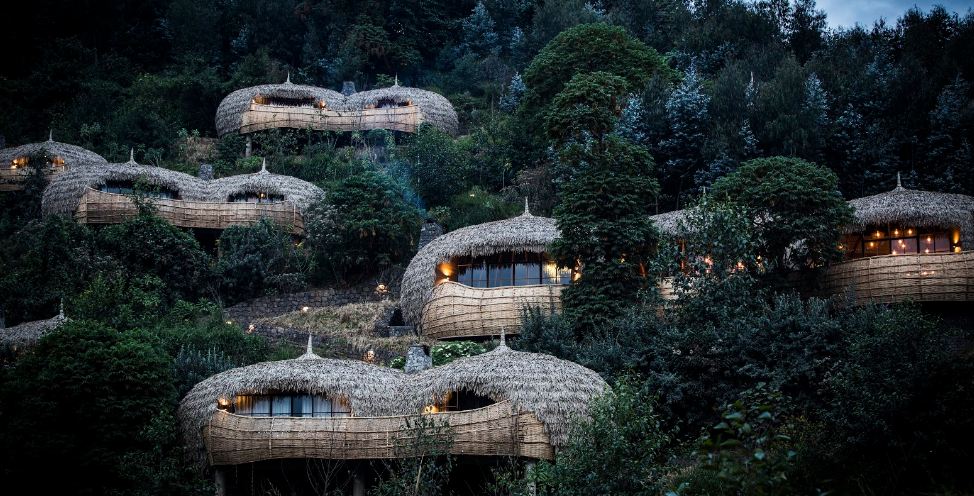
The only visitors allowed in the park overnight are those that have booked multiple-day hiking excursions to the top of Mount Karisimbi. However, there are many accommodation options ranging from budget hotels to ultra-luxurious safari lodges on the periphery of the park. These include:
- Bisate Lodge
- Sabyinyo Silverback Lodge
- One&Only Gorilla’s Nest Lodge
- Virunga Lodge
- Singita Kwitonda Lodge
- Five Volcanoes Boutique Hotel
- Mountain Gorilla View Lodge
- Tiloreza Eco Lodge
- Garden Palace Hotel
Best Time to Visit Volcanoes National Park In Rwanda
Volcanoes National Park is open year-round, though the “best time” to visit is from June until September — the long dry season. Though the highest rainfall levels occur from March to May and again in October and November, this is an equatorial region, and rain is possible at any time. And, naturally, the famous mists do more than just hide the gorillas. Consequently, it is essential to waterproof all electronics and photographic equipment, and a good pair of non-slip, waterproof walking boots is vital.
